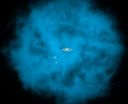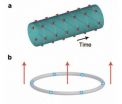(Press-News.org) Astronomers have used NASA's Chandra X-ray Observatory to find evidence our Milky Way Galaxy is embedded in an enormous halo of hot gas that extends for hundreds of thousands of light years. The estimated mass of the halo is comparable to the mass of all the stars in the galaxy.
If the size and mass of this gas halo is confirmed, it also could be an explanation for what is known as the "missing baryon" problem for the galaxy.
Baryons are particles, such as protons and neutrons, that make up more than 99.9 percent of the mass of atoms found in the cosmos. Measurements of extremely distant gas halos and galaxies indicate the baryonic matter present when the universe was only a few billion years old represented about one-sixth the mass and density of the existing unobservable, or dark, matter. In the current epoch, about 10 billion years later, a census of the baryons present in stars and gas in our galaxy and nearby galaxies shows at least half the baryons are unaccounted for.
In a recent study, a team of five astronomers used data from Chandra, the European Space Agency's XMM-Newton space observatory and Japan's Suzaku satellite to set limits on the temperature, extent and mass of the hot gas halo. Chandra observed eight bright X-ray sources located far beyond the galaxy at distances of hundreds of millions of light-years. The data revealed X-rays from these distant sources are absorbed selectively by oxygen ions in the vicinity of the galaxy. The scientists determined the temperature of the absorbing halo is between 1 million and 2.5 million kelvins, or a few hundred times hotter than the surface of the sun.
Other studies have shown that the Milky Way and other galaxies are embedded in warm gas with temperatures between 100,000 and 1 million kelvins. Studies have indicated the presence of a hotter gas with a temperature greater than 1 million kelvins. This new research provides evidence the hot gas halo enveloping the Milky Way is much more massive than the warm gas halo.
"We know the gas is around the galaxy, and we know how hot it is," said Anjali Gupta, lead author of The Astrophysical Journal paper describing the research. "The big question is, how large is the halo, and how massive is it?"
To begin to answer this question, the authors supplemented Chandra data on the amount of absorption produced by the oxygen ions with XMM-Newton and Suzaku data on the X-rays emitted by the gas halo. They concluded that the mass of the gas is equivalent to the mass in more than 10 billion suns, perhaps as large as 60 billion suns.
"Our work shows that, for reasonable values of parameters and with reasonable assumptions, the Chandra observations imply a huge reservoir of hot gas around the Milky Way," said co-author Smita Mathur of Ohio State University in Columbus. "It may extend for a few hundred thousand light-years around the Milky Way or it may extend farther into the surrounding local group of galaxies. Either way, its mass appears to be very large."
The estimated mass depends on factors such as the amount of oxygen relative to hydrogen, which is the dominant element in the gas. Nevertheless, the estimation represents an important step in solving the case of the missing baryons, a mystery that has puzzled astronomers for more than a decade.
Although there are uncertainties, the work by Gupta and colleagues provides the best evidence yet that the galaxy's missing baryons have been hiding in a halo of million-kelvin gas that envelopes the galaxy. The estimated density of this halo is so low that similar halos around other galaxies would have escaped detection.
INFORMATION:
The paper describing these results was published in the Sept. 1 issue of The Astrophysical Journal Letters. Other co-authors were Yair Krongold of Universidad Nacional Autonoma de Mexico in Mexico City; Fabrizio Nicastro of Harvard-Smithsonian Center for Astrophysics in Cambridge, Mass.; and Massimiliano Galeazzi of University of Miami in Coral Gables, Fla.
NASA's Marshall Space Flight Center in Huntsville, Ala., manages the Chandra program for NASA's Science Mission Directorate in Washington. The Smithsonian Astrophysical Observatory controls Chandra's science and flight operations from Cambridge.
NASA's Chandra shows Milky Way is surrounded by halo of hot gas
2012-09-25
ELSE PRESS RELEASES FROM THIS DATE:
Melting Arctic ice cap at record
2012-09-25
Think of the poor hamster on the treadmill. Steadily picking up speed and caught up by the momentum, unable to stop until it is overwhelmed and sent tumbling, crashing out of control inside the spinning wheel.
That's the analogy John Yackel, head of the Department of Geography, makes when he considers the annual summer ice melt in the Arctic, which he's been closely monitoring for the past 15 years, documenting the ice cover as it has steadily shrunk in the wake of Arctic and global warming.
Last week marked the unofficial peak, or the end of the summer ice melt, ...
Automatic building mapping could help emergency responders
2012-09-25
CAMBRIDGE, MA -- MIT researchers have built a wearable sensor system that automatically creates a digital map of the environment through which the wearer is moving. The prototype system, described in a paper slated for the Intelligent Robots and Systems conference in Portugal next month, is envisioned as a tool to help emergency responders coordinate disaster response.
In experiments conducted on the MIT campus, a graduate student wearing the sensor system wandered the halls, and the sensors wirelessly relayed data to a laptop in a distant conference room. Observers in ...
A clock that will last forever
2012-09-25
Imagine a clock that will keep perfect time forever, even after the heat-death of the universe. This is the "wow" factor behind a device known as a "space-time crystal," a four-dimensional crystal that has periodic structure in time as well as space. However, there are also practical and important scientific reasons for constructing a space-time crystal. With such a 4D crystal, scientists would have a new and more effective means by which to study how complex physical properties and behaviors emerge from the collective interactions of large numbers of individual particles, ...
Viruses help MU scientists battle pathogenic bacteria and improve water supply
2012-09-25
Infectious bacteria received a taste of their own medicine from University of Missouri researchers who used viruses to infect and kill colonies of Pseudomonas aeruginosa, common disease-causing bacteria. The viruses, known as bacteriophages, could be used to efficiently sanitize water treatment facilities and may aid in the fight against deadly antibiotic-resistant bacteria.
"Our experiment was the first to use bacteriophages in conjunction with chlorine to destroy biofilms, which are layers of bacteria growing on a solid surface," said Zhiqiang Hu, associate professor ...
First-ever treatment for rare childhood aging disease shows improvement in all trial participants
2012-09-25
BOSTON, MA (September 24, 2012) – Results of the first-ever clinical drug trial for children with Progeria, a rare, fatal "rapid-aging" disease, demonstrate the efficacy of a farnesyltransferase inhibitor (FTI), a drug originally developed to treat cancer. The clinical trial results, completed only six years after scientists identified the cause of Progeria, included significant improvements in weight gain, bone structure and, most importantly, the cardiovascular system, according to The Progeria Research Foundation (PRF) and Boston Children's Hospital. The study results ...
Florida State University chemist may hold key to building a better toxin mousetrap
2012-09-25
TALLAHASSEE, Fla. — A Florida State University chemist's work could lead to big improvements in our ability to detect and eliminate specific toxins in our environment.
Featured on the cover of the prestigious Journal of the American Chemical Society (JACS), Sourav Saha's specialized work to strip electrons from the toxic chemical known as fluoride is producing a variety of unique results.
"I started out with the very basic premise of trying to find new ways to detect toxic fluoride in solutions," said Saha, an assistant professor of chemistry at Florida State. "As ...
Treating ovarian cancer: New pathways through genetics
2012-09-25
This press release is available in French.Montreal, September 24, 2012 – A new discovery that sheds light on the genetic make up of ovarian cancer cells could explain why some women survive longer than others with this deadly disease. A multi-disciplinary team led by the Research Institute of the McGill University Health Centre (RI MUHC), in collaboration with the Lady Davis Institute of the Jewish General Hospital and the University of Montreal Hospital Research Centre, has identified genetic patterns in ovarian cancer tumours that help to differentiate patients based ...
Exposing cancer's lethal couriers
2012-09-25
Malignant cells that leave a primary tumor, travel the bloodstream and grow out of control in new locations cause the vast majority of cancer deaths. New nanotechnology developed at Case Western Reserve University detects these metastases in mouse models of breast cancer far earlier than current methods, a step toward earlier, life-saving diagnosis and treatment.
A team of scientists, engineers and students across five disciplines built nanochains that home in on metastases before they've grown into new tissues, and, through magnetic resonance imaging, detect their locations. ...
White matter, old dogs, and new tricks at Dartmouth
2012-09-25
Most people equate "gray matter" with the brain and its higher functions, such as sensation and perception, but this is only one part of the anatomical puzzle inside our heads. Another cerebral component is the white matter, which makes up about half the brain by volume and serves as the communications network.
The gray matter, with its densely packed nerve cell bodies, does the thinking, the computing, the decision-making. But projecting from these cell bodies are the axons—the network cables. They constitute the white matter. Its color derives from myelin--a fat that ...
Bone marrow holds secrets for treating colitis and Crohn's
2012-09-25
EAST LANSING, Mich. — Michigan State University researchers have unlocked secrets in bone marrow that could lead to improved treatments for colitis and Crohn's disease.
The results, featured in the current issue of Proceedings of the National Academy of the Sciences, show that the havoc inflammatory bowel diseases wreaks on the digestive tract is mirrored in bone marrow. Early indications also show that the disorders of the gut could potentially be treated through the bone marrow, said Pam Fraker, MSU University Distinguished Professor of biochemistry and molecular biology.
"It's ...




